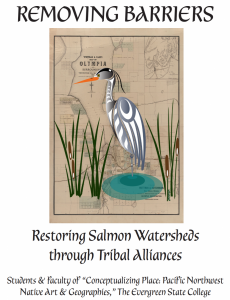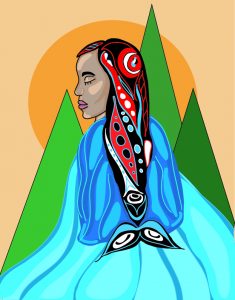By students of “Conceptualizing Place: Pacific Northwest Native Art and Geographies” (Alexander McCarty and Zoltán Grossman, faculty) at The Evergreen State College, Olympia WA (Winter 2021)

In Fall 2020 – Winter 2021, students in the “Conceptualizing Place: Pacific Northwest Native Art and Geographies” daytime program at The Evergreen State College produced a 132-page publication about barriers to salmon runs, notably dams, dikes, and culverts, and how tribal nations have led alliances to remove some of the barriers in order to restore salmon habitat in Northwest watersheds.
The place-based stories of habitat restoration highlight how treaty rights and tribal sovereignty have become leading drivers of reversing damage wrought by settler colonialism, and how the healing of the watersheds and their estuaries is made possible by a process of decolonization and reindigenization in corresponding Indigenous homelands.
In Removing Barriers: Restoring Salmon Watersheds through Tribal Alliances, narratives of the watersheds are told through text, graphics, and students’ 42 original digital artworks and maps, as students simultaneously learned Northwest Native histories, geographies, and art styles.
The book’s theme of “removing barriers” applies to the barriers to salmon runs, barriers between human beings and the natural world, barriers between Native and non-Native communities, and barriers to Indigenous self-determination.
Students’ twelve chapters highlighted the Nisqually, Elwha, Skokomish, Chico, White Salmon, Nooksack, White, Deschutes, Chehalis, Klamath, and Snake watersheds, as well as background on dams and climate change, and their effects on Pacific salmon, orcas, and coastal communities (see Contents below for links to two parts).
The publication is an example what what Evergreen students can accomplish in interdisciplinary, team-taught programs. Under the remote supervision of faculty (artist Alexander McCarty and geographer / cartographer Zoltán Grossman), individual students produced Adobe Illustrator artwork and maps in fall quarter 2020, and student teams produced the Adobe InDesign layouts in winter quarter 2021. Media Services staff offered their invaluable training and assistance.
Faculty and students greatly appreciate support from The Evergreen State College Foundation, Longhouse Education and Cultural Center, Suquamish Foundation, The Natural History Museum, 4Culture (King County), and the Endangered Species Coalition to print and distribute this publication; other partnerships are welcome.
Removing Barriers can be downloaded here as Part 1 and Part 2.
Print the PDFs double-sided, and “Print to Fit” the page.
Faculty and student presentation (49 min.) on Removing Barriers, at Evergreen’s Equity Symposium (4/14/21).
Zoltán Grossman presentation on book project (20 min.) to the American Association of Geographers (AAG) (2/28/22).
“Submergence: Going Below the Surface with Orca and Salmon” exhibit at Seattle’s Jack Straw Cultural Center in 2021. Thanks to the Endangered Species Coalition for including examples of student artwork from Removing Barriers in the opening video. View the online opening (75 min.) (6/4/21).
Nisqually Delta Restoration Puzzle: free download of color art project by Evergreen faculty emeritus Lucia Harrison.
CONTENTS
DOWNLOAD PART 1
(39 MB, 69 pages):
Introduction: Removing Barriers
(Zoltán Grossman and Alexander McCarty, faculty)
Cover, Table of Contents, Indigenous guest artists, Student artwork & maps, Class & project overview
- Dams, Dikes, and Culverts: Blocking the Flow of Life
(Jansan Helligso and Alex Marroquín)
Technical overview of barriers to salmon runs, and the process of removing them, and connections to the climate crisis. - Nisqually: Restoration and Healing
(Vanessa Harriss, Tristan Glaser, and Madelain Stier)
Nisqually Tribe and dike removal in Nisqually Delta estuary in the South Sound, collaborative restoration of upper watershed, and changes in dam practices.\ - Elwha: Reclaiming a Lifesource
(Annabelle Anderson and Anthony Grandberry)
Lower Elwha Klallam Tribe and allies’ removal of the Elwha and Glines Canyon dams in the northern Olympic Peninsula. - Skokomish: Collaborative Restoration of an Obstructed River
(Amanda Flegel and Hunter Herman)
Skokomish Tribe’s settlement on the Cushman dams, and cooperation to restore watershed near Hood Canal. - Chico: Restoring the Place of the Chum Salmon
(Bridget Marsch-Grim)
Suquamish Tribe collaboration to fix Chico Creek culverts on Kitsap Peninsula.
DOWNLOAD PART 2
(34 MB, 63 pages): - White Salmon: Persistence and Renewal
(Dylan Posos)
Yakama Nation and the removal of the Condit Dam on the White Salmon River off the Columbia. - Nooksack & White: Removal to Restoration
(Reno Buchanan and Milo Nauman)
Nooksack and Lummi tribes and removal of the Middle Nooksack Dam, Muckleshoot Tribe and the Howard H. Hanson Dam, Muckleshoot and Puyallup Tribes and Mud Mountain Dam and Buckley Fish Passage. - Deschutes: Restoring the Estuary
(Griffin Hart and Tierra McCarty)
Squaxin Island and Nisqually tribes’ demands for removal of the 5th Avenue Dam that forms Capitol Lake in Olympia, and community work for restoration of the Deschutes Watershed. - Chehalis: Lifeblood of the People
(Ashes Gleason, Mike Crosby, and James Martinez)
Chehalis, Quinault, and allies’ opposition to the proposed flood retention dam on the Chehalis River in western Washington, and alternate plans for flood control and salmon protection. - Klamath: Sacred Waters Obstructed by an Iron Gate
(Parker Wong and Nathan Epstein)
Klamath, Yurok, Hoopa tribes, fishers, and environmentalists’ “water wars” with farmers in southern Oregon and northern California, and agreement to remove four Klamath River dams. - Snake: Constricting and Unconstricting the River
(Megan Richard and Hasani Patterson)
Nez Perce, Umatilla, Warm Springs, Yakama tribes, fishers, and environmentalists’ demands to remove four Lower Snake River dams in eastern Washington, farmers’ opposition, and possible agreement for removal. - Pacific Coast: Waiting for Chinook
(Carson Bayness, Jennipher Brewer, and Andrew Williamson)
Effects of dams, noise, toxins, and climate change on Pacific salmon, orca whales, and coastal fishing communities, including the Quinault, Quileute, and Makah nations.
©2021 The Evergreen State College.
Printed by Gorham Printing, Centralia WA
The views, opinions, and positions expressed by individual authors in this publication are theirs alone, and do not necessarily reflect the views, opinions, or positions of The Evergreen State College.
Citation: Grossman, Z. & McCarty, A. [Eds.] (2021, Winter). Removing Barriers: Restoring Salmon Watersheds through Tribal Alliances. Conceptualizing Place: Pacific Northwest Native Art & Geographies, Olympia WA: The Evergreen State College.

